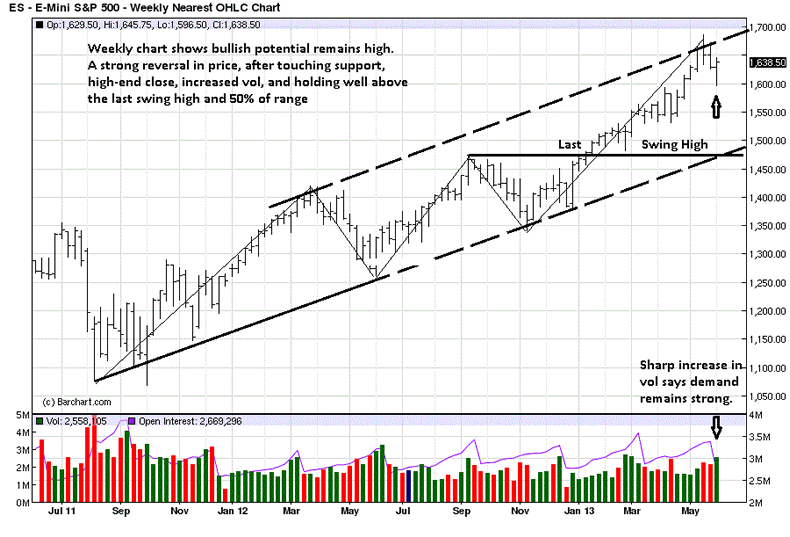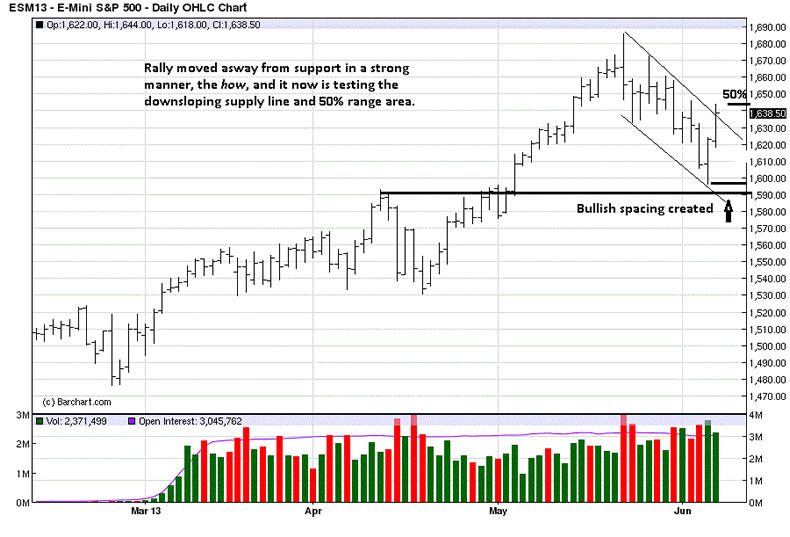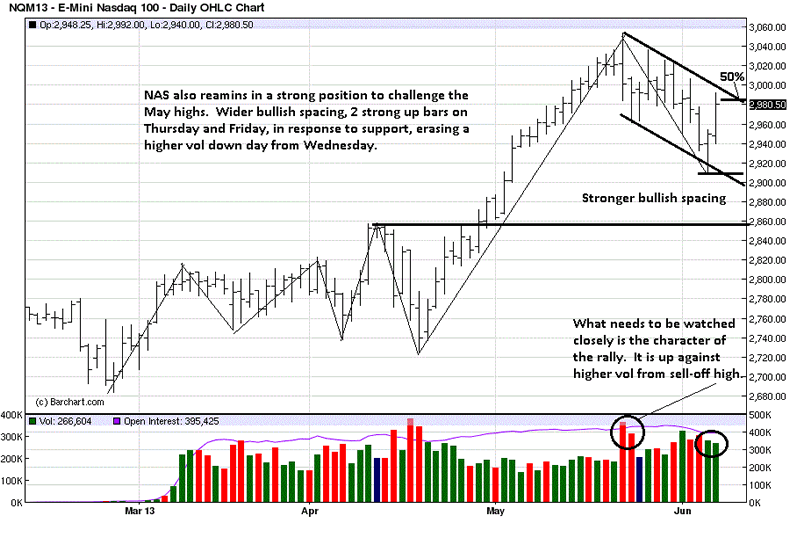Stock Market Index Trend, Facts, Rules Equals Successful Results
Stock-Markets / Stock Markets 2013 Jun 10, 2013 - 06:42 AM GMTBy: Michael_Noonan
 Markets provide an opportunity to grow one's capital, and create a return on capital, in addition to a return of capital, its preservation being the benchmark to ensure it remains fully intact. Is there a magical formula for success in the markets? No. However, there is a realistic approach to increase the odds of consistent returns while keeping exposure to risk at an acceptable level.
Markets provide an opportunity to grow one's capital, and create a return on capital, in addition to a return of capital, its preservation being the benchmark to ensure it remains fully intact. Is there a magical formula for success in the markets? No. However, there is a realistic approach to increase the odds of consistent returns while keeping exposure to risk at an acceptable level.
The S&P used to be our mainstay market concentration, but we stepped away from that market when central planners took over, starting with POMO, [Permanent Open Market Operations], conducted by the privately owned Federal Reserve. With fiat being pumped into the markets on an ongoing basis, it was a fatal blow to free market operations, where supply and demand were the true measures of value. Now, [then], there was only an artificial demand that took quarrel with any attempts by supply to alter the Fed's upward trajectory.
These circumstances were unacceptable, and so we withdrew from analyzing the equity markets, rightly or wrongly, but right for us. There may be change coming, and if/when it does, 2008 will likely be relived, again, possibly worse, given how the buy side market has become so distorted. It is now back to our game plan, and greater attention will be given to reading developing market activity, which is what we do.
Are successful results possible? Absolutely! There are never any guarantees in obtaining profitable results, but we know for certain that guidelines exist for gaining an edge in all markets: Trend, Facts, and Rules.
The trend is the most important first piece of knowledge one can have in order to become profitable. Trends persist in the market, and they often go much farther than many think likely. If you want to be successful, you must always trade in the direction of the trend, in whatever time frame chosen. Plus, one must also be mindful of the next higher time frame to not run into a larger, potentially opposing force. Just this one observation, alone, can enhance one's odds for success.
Facts. They are incontrovertible, conclusive, not subject to dispute. Facts are in direct opposition to opinions, themselves subject to beliefs or judgment, both of which fall short of certainty. We want as much certainty in decision-making as possible. Facts provide that.
There are ways of determining the trend based on facts. There are ways of determining which force, supply or demand, is in control, based on facts. When you take the trend and combine it with factual market observations, it results in creating an edge for every market decision that can lead to stock market success. There is one more element.
Rules, the missing ingredient for a majority of market participants. What undercuts successful trading/investing more than anything else? Having an opinion. We all have them, but they cannot be the compass upon which decision-making is based. Why not? Opinions are subjective, and almost always charged with emotion, ego, both of which are destabilizing factors.
Why do so many people lose so much money? They have an opinion about what a market will/should do. "This market can't go much higher." But it does. [Trend]. "The market is overdue for a correction." It may be, but it does not correct. [Trend]. Once positioned in a market, emotions take over. "I can't take a loss. The market will bounce back." [Going against the trend and ignoring the facts.] You get the idea.
Rule One: Trade with the trend. Rule two: Buy strength, not weakness. Rule three: Buy at support, once proven it will hold. Etc, etc, When you have a fixed set of rules that determine when to take a position within an established trend, the risk factors have been greatly reduced, and the odds for success have been enhanced. Neither is guaranteed, but the odds of probability are now tilted on your favor.
With this brief, but comprehensive groundwork, we apply it to better understanding the charts and moving forward.
The first fact to determine for the weekly S&P is the trend, and clearly, it is up. You can see how the lighter line connects the swing highs and lows. The highs are higher and the lows are higher, the essence of a trend. [It does not matter how one defines a trend, as long as the guidelines for its determination are used consistently.]
It is also apparent that price closed higher for the week, and it did so on increased volume, both facts, regardless of what opinion someone may have. What does not show is how the weekly bar looked so weak, going into Thursday, and it appeared that the market would continue to sell off. However, the time frame is weekly, and we have to wait for the end of the week close in order to make a valid assessment. That would be a basic rule for weekly.
If one made a determination to take action, based upon apparent weakness on lower prices starting Thursday morning, that action would have been based upon a judgment made at the time, [and proven wrong]. Taking any action at that point would have meant it was based on opinion and a breaking of rules, or alternatively, not even having a set of rules in place, which is just as bad.
This is not to belabor the point, rather to drive home the importance of knowing the trend and adhering to rules, based upon market facts. The time frame is weekly, so no decision can be made until the close of the week is known, another fact. Despite the apparent drop in price, almost 50 points, starting out Thursday morning, the Trend, reasserted itself, and by day's end, price rallied the most in a single day from low to high close in many months.

The weekly chart shows a strong, trending market. Higher time frames are stronger than lower time frames. The daily chart had been selling off, longer in time and greater in price since the November 2012 lows. The sell-off was approaching a swing high support from April, and the bottom of the down sloping demand line.
The fact that price reversed and rallied so strongly from a known [potential] support area, demonstrated how and why knowing the trend is so important in order to react to the developing market activity and not be swayed by emotions. This is how to trade in the markets: knowing the trend, using facts gathered from the market, and having a set of rules for engagement.
What to do now?
Was the May high the high for this move? The trend says no. More evidence of a change is needed to make an informed decision.There are two likely scenarios. 1: The high is in and this is a retest of the high that will fail, leaving price to go lower. 2. This was just a natural correction within a bull market, and price will make higher highs, keeping the trend intact.
With a set of rules, the decision is an easy one. For now, we have to go with the trend is up and should be heeded scenario, until proven otherwise. We can also add the fact that the last swing low, from Thursday, [should it hold], left bullish spacing. The last swing low is above the last swing high, as the two horizontal lines show.
A weak retest of the 1596 low will confirm that the daily trend remains up. [The weekly is not close to turning, at this point.] What is a weak retest? Smaller range bars and lower volume when price declines, indicating sellers are not in control, as one example. Should that happen, it can set up another buy opportunity, next week.

The NASDAQ shows greater spacing between last Thursday's low and the mid-April swing high. It is testing 50% of the previous range, a general guide, indicating overall strength. There is a slight conflict between the stronger volume on the sell-off from the May high, compared to the lesser volume from last week's rally. The possible offset to that negative is the fact that price rallied so easily from the low. Where were the sellers to stop the buyers?
Bottom line is, in both markets the trend remains up, and a solid set of rules to determine when to buy within an uptrend will best serve one's objective of consistently profitable trading success.

By Michael Noonan
Michael Noonan, mn@edgetraderplus.com, is a Chicago-based trader with over 30 years in the business. His sole approach to analysis is derived from developing market pattern behavior, found in the form of Price, Volume, and Time, and it is generated from the best source possible, the market itself.
© 2013 Copyright Michael Noonan - All Rights Reserved Disclaimer: The above is a matter of opinion provided for general information purposes only and is not intended as investment advice. Information and analysis above are derived from sources and utilising methods believed to be reliable, but we cannot accept responsibility for any losses you may incur as a result of this analysis. Individuals should consult with their personal financial advisors.
Michael Noonan Archive |
© 2005-2022 http://www.MarketOracle.co.uk - The Market Oracle is a FREE Daily Financial Markets Analysis & Forecasting online publication.



